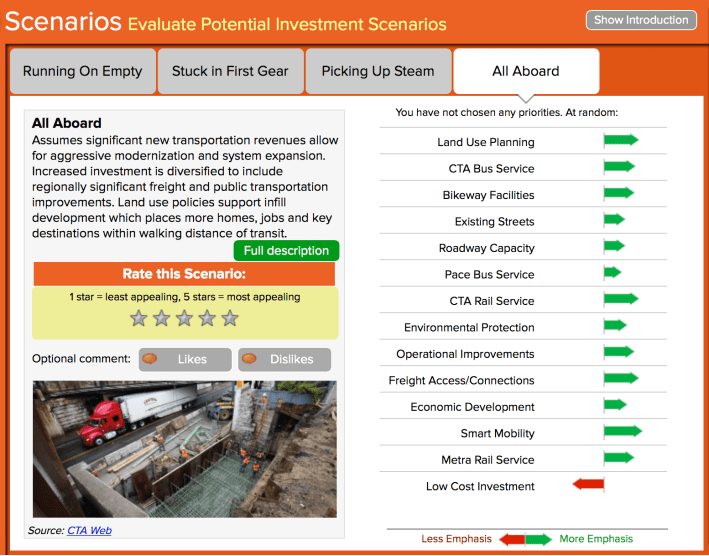Earlier this year, Cook County embarked on its first transportation plan since 1940, asking residents to weigh in on how and where to improve transportation across the second most populous county in America. That feedback has helped the transportation department to draft a new vision statement [PDF] – that world-class transportation will spur economic growth and enhance quality of life – plus four scenarios for the future [PDF], which the public can vote on in an online survey.
The new plan will guide policy choices that determine where and how the county invests its resources, and to estimate how much more revenue is needed to fulfill those goals. One key policy decision will determine whether or not the region will fight for more resources in Springfield. One particularly galling imbalance is the Illinois Department of Transportation's strict 55/45 split, which sends an outsized proportion of dollars downstate even though most of the state's people and economy reside in Chicagoland.
The most dour of the four scenarios envisioned is called "Running on Empty." It supposes that the current conditions depressing local transportation investment – the 55/45 split, declining gas tax revenues, municipalities looking out only for themselves, and sprawling, low density growth – will continue to "undermine" Cook County's transportation system, communities, and economy.
A slightly less depressing scenario, "Stuck in First Gear," differs minimally from the first by supposing that the county will pursue additional grants from the state and federal governments. The county would rein in sprawl slightly by encouraging more density around train stations, for example. This would increase use of some underutilized bits of the transportation system, but also tax others, similar to how some parts of the CTA system are now becoming overcrowded. However, an overall lack of funding leads transit service quality to continue its long-term decline, making transit-oriented development a tough sell.
Scenarios three and four more closely reflect the goals of the GO TO 2040 regional plan, but depend on the state to update its antiquated policies. "Picking Up Steam" says that Cook County would stop diverting gas tax revenues away from infrastructure, and influence the state to do the same. And instead of distributing transportation funds by a strict 55/45 split, the Illinois Department of Transportation would use performance measures to guide dollars to where they're most needed, e.g., densely populated Cook County. Those policy changes would add funds that could address the area's considerable maintenance backlog, and start to invest in more bicycle, pedestrian, and transit projects. However, the third scenario isn't all rosy: It's marred by development that continues to drift further away from existing transit and freight facilities.
The final scenario, "All Aboard," is one which supposes additional funding and new development surrounding existing transportation resources. Specifically, it assumes that the state gas tax will be raised by eight cents per gallon, and pegged to inflation. Policy changes would target county revenues towards compact and mixed-use development on infill locations, and expand regional transit "to reach underserved destinations." Building within existing neighborhoods is a core tenet of GO TO 2040, and focusing new spending there would stabilize neighborhoods and expand businesses.

Both these scenarios and the Transit Future campaign call for new revenues. This year, though, Cook County President Toni Preckwinkle has deferred introducing a new transit revenue source, instead prioritizing a fix for the county's underfunded pensions.
Increased transportation investment could spur economic development, and thus tax revenue for the county, especially if directed to income-generating investments like transit rather than roads that drain funds and damage the environment.
The county prefers "All Aboard," but it's not clear how increasing the gas tax (in particular) would necessarily lead to transit enhancements. Gas tax revenue is primarily spent to maintain and build new roads, with a small portion of IDOT funds going to the Regional Transportation Authority. Some of this would be offset in "All Aboard," since it also recommends congestion pricing "to reduce driving" and generate funds for other modes.
That link between transit and economic development could be clarified in the County's draft transportation plan. For example, the Victoria Transport Policy Institute says that in North America, regions with less driving (as measured by vehicle miles traveled) "tend to be more economically productive," as are regions with high transit use [PDF], high fuel prices, and dense land uses. Road capacity, on the other hand, brings down productivity.
As with all scenario plans, the Cook County transportation plan relies on a lot of assumptions. In particular, the county would have to flex a lot of political muscle to get IDOT to drop its 55/45 split, and then to use gas tax revenues for broad transit improvement projects instead of for more roads. Cook County, and the rest of the region, could take a tip from Los Angeles' winning strategy to enact a small sales tax increase for transportation, and go all-in to realize both the transit ridership and pollution reduction goals in GO TO 2040.
L.A.'s sales tax hasn't freed it from financial struggles, but the fact that they took a risk and invested political capital to raise taxes (by popular vote, too) paid off, both in terms of increased federal resources for expanding transit and ultimately, a stronger and more productive regional economy.




